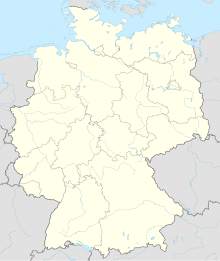Faberge Museum

Street view
|
|
| Established | 9 May 2009 |
|---|---|
| Location | Baden-Baden |
| Coordinates | 48°45′43″N 8°14′35″E / 48.762°N 8.243°E |
| Collection size | 3,000 |
| Website | Fabergé Museum website (in German) |
The Fabergé Museum is a museum located in the German spa city of Baden-Baden, dedicated to items made by the Russian jewellery firm Fabergé. It was opened in 9 May 2009 by Russian art collector Alexander Ivanov.
The museum's collection numbers almost 700 items made by Fabergé. The most significant item in the museum's collection is the Rothschild Fabergé egg, that was made as an engagement gift from Béatrice Ephrussi de Rothschild to her brother's fiancée. Ivanov bought it at the auction house Christie's in London on 28 November 2007, for £9 million because he thinks that it’s the “finest ever” made by Fabergé.
Besides the Rothschild Fabergé Egg, other items in the museum collection include a rare silver decanter in the form of a rabbit, and the last Fabergé Egg, the Karelian Birch egg made of Karelian birch with gold and diamonds for Easter 1917. Czar Nicholas II, however, was deposed before he could give it to his mother. When Ivanov first bought the Karelian egg, some experts resisted because its existence wasn’t known previously. Ivanov now has documents found in the Russian state archives proving the egg is genuine.
The Fabergé company was founded in St. Petersburg in 1842, and it was an official supplier to the Russian Imperial court from 1885 to 1917. It also supplied high-end luxury goods to the Russian and European aristocracy. Besides the czars, clients include the Queen of the United Kingdom, and the royal family of Siam (now Thailand). Fabergé was closed after the Bolsheviks seized power in 1917, and its exquisite items were almost forgotten and no longer cherished. The company’s artworks became popular again in the 1960s with Western collectors, led by Malcolm Forbes. Prices rose to records in the early part of the 21st century thanks to Russians such as Ivanov who took a fancy to fine artworks that comprise their country’s heritage.
...
Wikipedia

